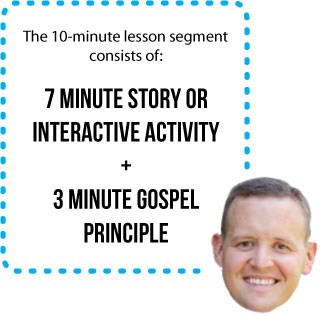Several months ago I attended the Mother's Retreat at Southern Virginia University. Hank Smith was one of the keynote speakers, and I attended the conference with the specific goal of analyzing his speaking/teaching style. Brother Smith does a number of things to help listeners stay engaged during his lessons that you can apply in your lessons, today. For this first article, I'm going to talk about his 10-minute lesson segment.
The Hank Smith 10-minute Lesson Segment
I noticed that Brother Smith teaches principles in small, ten-minute long segments that follow a very definite pattern. Each lesson segment is made up of an approximately 5-7 minute long anecdote or activity, followed by a 3-5 minute gospel principle teaching summary. Each of these teaching segments lasts 10 minutes. In my observation, this 10 minute teaching technique
- helps learners stay engaged
- helps the teacher stay on task
- helps ensure specific principles are taught, and
- helps the presentation end on time.
I was specifically interested in lesson pacing to improve my own teaching. In my notebook I wrote down the time of each lesson transition. I noted three times during his talk when Brother Smith used 10-minute lesson segments. During the fourth lesson segment, he got a lot of interaction from the audience that threw him off his schedule a bit, and he went long. This isn't necessarily a bad thing -- it's good to get the class warmed up and participating -- but if you plan your lessons in lesson segments, be sure to leave a little space at the end for you to summarize your lesson for an on time ending and in case the class gets very excited about a specific topic.

10-minute lesson segment examples
Below are some lesson segments Brother Smith used during his talk:
- 7 minute anecdote + 3 minute uplifting principle: The theme of this segment was Real vs Ideal motherhood. For 7 minutes, he shared humorous anecdotes from women he had asked about the realities of motherhood. After laughing together for several minutes, he changed shifted into a more serious tone and taught us it was okay to be a Real Mom, and Real Moms make mistakes.
- 5 minute interactive group attention-getter + 5 minutes of fact-based learning: Brother Smith displayed a slide of a Van Gogh painting, and encouraged the audience to talk about it. "Which brush stroke made this painting worth 120 million dollars?" he asked. In isolation, a single brush stroke is not very important. Happiness, he taught, is not a single brushstroke. The small actions of a parent change the landscape of our lives. Here Brother Smith turned to the theme of happiness, educating the class with interesting statistics about the effects of parents and income on happiness based on his graduate work.
- 9 minute list discussion + 1 minute group goal-setting activity: Brother Smith put up a slide with a list of habits of happy people. They make an effort to be happy; they spend money on other's happiness; they have deep, in-person conversations; they laugh; they listen to music; they exercise and have a healthy diet; they go outside 20 minutes/day; they get enough sleep; they take time meditate. After discussing the material, Brother Smith invited the group to turn to a friend and tell them something they themselves can do better. (In other words, he asked attendees to share aloud something they had learned and make an oral commitment to a friend to change.)
The takeaway
Based on my observations of Brother Smith, I learned a few things that I think we can apply to our own gospel teaching.
Timing matters
Lesson timing does matter. Ten-minute shifts helps keep the class from becoming bored, and it helps keep the teacher on track.
I already plan my lessons in segments. In fact, I actually write down the amount of time I think an activity will take in the margin of my notes. I also mark a segment that I think I can drop if a very important discussion goes long. My lesson segments are not always 10 minutes long, but I rarely plan a single activity to take up more than 25 minutes of class time.
Planning a lesson with timing in mind helps students avoid boredom and stay engaged with the material, and you will be able to craft lessons that make specific points to help students come to Christ.
Vary your methods
Though Brother Smith's timing is pretty rigid, his presentation did not feel robotic. This is because he used several different methods to vary his presentation. Brother Smith used humorous stories, rhetorical questions, visual aids, lists, and group interaction, all within a single 40-minute presentation. You, too, can use this level of variation in your lessons with great effectiveness.
One teacher I know is a uses a powerpoint for every lesson he teaches. He has found it to be helpful for keeping students on track with scripture references, and it helps him make the points he'd like to during each lesson. However, this intermediate teacher has not learned that a powerpoint may not be the best technique to teach every lesson. When overused, a new method becomes a crutch, not a teaching tool. This brings me to the next point:
FIRST, pick your point, THEN pick a technique
It was obvious to me that Brother Smith had carefully chosen the 3-5 points he wanted to teach, and THEN he chose the technique he felt would keep students engaged as they learned about it together. Brother Smith did not let the methods he used dictate what he taught. Rather, he chose his teaching technique after deciding which point to teach.
Sometimes after a teacher has been teaching a while, he or she may decide to add variety to a lesson. He or she chooses an activity that sounds like fun, and then adapts their lesson to use that activity. In my opinion, the difference between an intermediate gospel teacher and and advanced gospel teacher is that the advanced gospel teacher chooses from an arsenal of teaching techniques to teach the gospel, rather than trying to adapt a lesson to a given technique. In fact, I think this is so important that I have collected hundreds of teaching techniques that I and others have used, indexed them, and shared them online so that you can select a teaching technique that will help you accomplish the goals you have for your classroom.
Avoiding the pet topic
The topic of Brother Smith's presentation was supposed to be the influence of a righteous mother. It seemed to me (and I could be wrong) that he recycled some old slides from presentations he does at youth conferences and just replaced young women with mothers for our retreat. The material was based on his studies on happiness, and though educational and entertaining, his presentation was only marginally related to the topic. It was a pet topic he was passionate about, and it appeared Brother Smith assigned his favorite topic to the group, rather than determining if that topic closely fit the stated purpose of the event. This is common for professional presenters, and even desirable as those who engage a professional presenter often want a repeat of a presentation they heard before. Gospel teachers, however, have a different purpose and should try to avoid pet topics during their teaching.
I have attended Sunday School only a few times this year, and I've heard the same story during three of the five lessons I've heard from a particular teacher. The information you have to share may be inspiring and very exciting to you, however, it is important when we are teaching that we make the lesson about the students first. You may not get to teach the topic you are most comfortable teaching or most excited about. However, lessons that are geared toward students first and teachers interests second are the most life-changing.
With the new two-hour block, gospel teachers should have plenty of time to seek inspiration and carefully plan lessons *for students* rather than falling back on something that is Old Reliable or a Pet Topic.
Part Two - Coming soon.....


